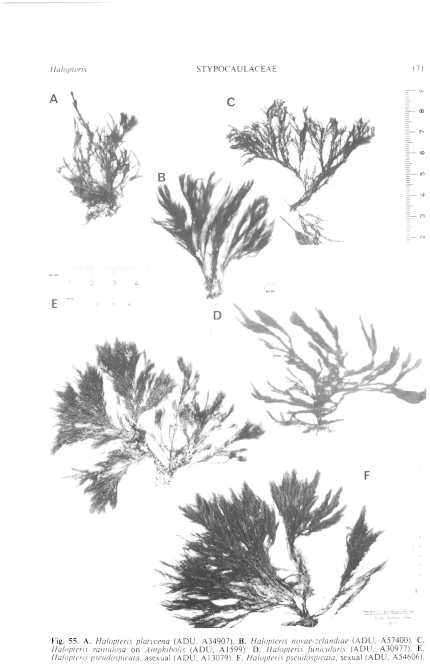|
|
|
|
|
|||||||||||
|
Electronic Flora of South Australia Species Fact Sheet
Phylum Phaeophyta – Order Sphacelariales – Family Stypocaulaceae
Selected citations: Womersley 1967: 205.
Synonym
H. scoparia sensu Sauvageau 1904; 377 (Australian specimen).
Thallus (Fig. 55C) medium to dark brown, 4–12 (–20) cm long. with a rhizoidal holdfast 2–8 mm across and numerous, erect, pinnately much branched axes, often basally denuded; epilithic or on Amphibolis. Branching of 3–4 orders, usually regularly alternately distichous with laterals every (2–) 3–6 (–12) segments (Fig. 57A,B), with lesser laterals determinate and tapering to small apical cells (Fig. 57C); lower and mid axes producing descending rhizoids which corticate the axes and form the basal holdfast; phaeophycean hairs absent. Axes (Fig. 57B,C) 120–160 (–190) µm in diameter with segments L/B 0.5–1.0, corticated by small, rectangular cells in rows of 2–4, and rhizoids below; primary laterals 70–90 µm in diameter with segments L/B (0.4–) 0.5–0.8 (–1.0); ultimate laterals (Fig. 57C,D) 50–90 µm in diameter near their bases with segments L/B 0.4–0.8; rhizoids arising from pericysts; adventitious branchlets absent.
Reproduction: Unilocular sporangia (Fig. 57C) densely clustered, formed in axillary groups on distichous (or slightly irregular) laterals, borne on simple or branched. 2–4 (–10) celled, straight to slightly curved pedicels, subspherical to slightly ovoid, (25–) 30–45 Aim in diameter. Sexual plants with oogonia and antheridia (Fig. 57D) borne in mixed clusters of 2–6 in axils of laterals, each with a 2–4 celled pedicel; oogonia subspherical, 65–90 µm in diameter; antheridia subspherical to ovoid, 60–70 pm in diameter.
Lectotype from "Nov. Holl. .Aust." (Algae Muellerianae): in Herb. Sauvageau, PC.
Selected specimens: Eucla, W. Aust., drift (Womersley, 2.ii.1954; ADU, A19336). Stenhouse Bay, S. Aust., drift (Womersley, 9.iv.1950; ADU, A13224). Middle River, Kangaroo 1.. S. Aust., drift ( Womersley, 8.i.1946; ADU, A3380). Somerton, S. Aust., drift ( 4.iii.1944: ADU, A1599). Marino, S. Aust., drift (Womersley, 18.vii.1965; ADU, A29230). West I., S. Aust., 25 m deep (Shepherd, 12.v.1973; ADU, A43571). Victor Harbor, S. Aust„ drift (
Distribution: From Eucla, W. Aust., to Cape Northumberland. S. .Aust. (and Hobsons Bay. Vic.?), and the north coast of Tasmania.
Taxonomic notes: 17.x.1948; ADU, A9288, sexual). 11 km off Cape Northumberland, S. Aust., 48 m deep (Shepherd, 6.v.1975; ADU, A46285). Tamar R. Lighthouse. Tas. (Levring, 22.xi.1948; ADU, A56185).
II. ramulosa is not uncommon in the Gulf St Vincent region of South Australia, and appears to be confined to regions of moderate water movement or to deeper water. It has been collected at 15 to 48 m depths off Cape Northumberland and West Island.
It is closely related to H. scoparia from Europe, but differs in that the sporangia occur in axils of laterals which remain distichously (or sometimes slightly irregularly) branched and do not become tetrastichous as described for II. scoparia. The sporangia of II. ramulosa are usually in compact clusters, each on 2–4 celled pedicels, but in A43571 and A46285 (both deep water collections) the pedicels have become up to 10 cells long, with the cluster appearing much looser and spreading further beyond the branch axils.
References:
WOMERSLEY, H.B.S. (1967). A critical survey of the marine algae of southern Australia. II. Phaeophyta. Aust. J. Bot. 15, 189–270.
The Marine Benthic Flora of Southern Australia Part II complete list of references.
Publication:
Womersley, H.B.S. (14 December, 1987)
The Marine Benthic Flora of Southern Australia
Part II
©Board of the Botanic Gardens and State Herbarium, Government of South Australia
Illustrations in Womersley Part II, 1997: FIGS 55C, 57 A–D.

Figure 55 enlarge
Fig. 55. A. Halopteris platycena (ADU, A34907). B. Halopteris novae-zelandiae (ADU, A57400). C. Halopteris ramulosa on Amphibolis (ADU, A 1599). D. Halopteris funicularis (ADU, A30977). E. Halopteris pseudospicata, asexual (ADU, A13079). F. Halopteris pseudospicata, sexual (ADU, A54606).

Figure 57 enlarge
Fig. 57. A–D. Halopteris ramulosa (A–C, ADU, A29230; D, ADU, A9288). A. Branching pattern of thallus, with sporangial sori in axils of lower ramuli. B. Upper part of an axis with laterals. C. Mid axis with sori of unilocular sporangia in axils of laterals. D. Sexual plant with axillary clusters of oogonia and antheridia. E–I. Halopteris funicularis (E–H, ADU, A30534; I, ADU, A20026). E. Thallus (sporangial) with irregular branching. F. Upper part of axis with laterals. G. Axis with laterals and axillary sori of unilocular sporangia. H. Part of a sorus with curved, clavate paraphyses and unilocular sporangia. I. Branch of a sexual plant with young (above) and mature (below) axillary systems with oogonia and antheridia.

|
Email Contact: State Herbarium of South Australia |

|